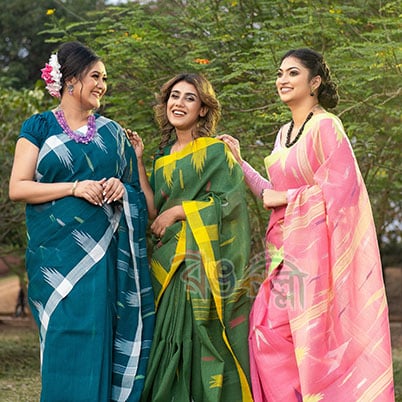Shop Monipuri Sarees: Discover the Rich Heritage of This Ethnic Tradition
Monipuri is a unique, rich ethnic group originating from the Indian state of Manipur. Social turmoil and wars in the late 18th and 19th centuries created the compulsion for the migration of many Monipuris, and a large chunk eventually settled in the Sylhet region of Bangladesh. Renowned for their special language and script, this community upholds an exceptional cultural heritage, especially their unrivaled skills in weaving.
Traditional Monipuri Sarees: A Sartorial Legacy
There is something about the dressing of a Monipuri woman that incites a charm from times well before the invention of sarees. They used to wear lahing or fanek with a blouse, furit, and a veil called fitup bainafi. Among them all, one particular veil, Mairangfi, was traditionally designed for the princess, which gave the inspiration behind today’s exquisite sarees of Monipuri.
Birth of Monipuri Saree Weaving in Bangladesh
In the early 1990s, Monipuri artisans came up with sarees based on Mairangfi. These sarees immediately became very popular due to their detailed designs, individual color contrasts, and motifs of temples. Each piece is a masterpiece, as no two sarees are the same.
Why Monipuri Sarees Are a Modern Favorite
Monipuri sarees are renowned for their colorfulness and inexpensiveness, costing from 1,200 to 7,000 BDT only. They serve as a very good substitute for the expensive Jamdani or muslin sarees. These are perfect for bringing cheer to dull moods with their bright colors and light-weighted fabrics. However, limited yarn availability has increased the prices slightly.
A Legacy of Handwoven Excellence
It must be said that weaving of Monipuri saree is indeed labor love. While preparing the yarn, the traditional spinning wheels are used and it does totally manual weaving, producing textiles filled with culture and history. Apart from sarees, they weave fanek, shawls, veils, three-piece suits, nakshikantha, and even embroidered home textiles, ranging from bedsheets to towels.
Monipuri Hand-woven Textiles in Sylhet: Not to Be Missed
Sylhet is the heart of Monipuri weaving, with shops brimming with beautiful handwoven sarees and textiles. These stores attract locals, tourists, and Sylheti expatriates eager to share these treasures worldwide. Moulvibazar, home to many Monipuri artisans, offers visitors a glimpse into the traditional weaving process, preserving a timeless craft.
Cultural Significance of Monipuri Weaving
Monipuri weaving is rather a craft that has served as a symbol of Bangladesh’s rich textile history, which started over a thousand years ago. This tradition continues to thrive to date, significantly contributing a great deal to the country’s cottage industries and also helping to preserve the nation’s heritage for future generations.
Wearing Care for Your Monipuri Saree
To maintain the beauty of your Monipuri saree
- Only wash gently with mild detergent, not more than 15 to 20 minutes.
- Avoid brushing or rough handling.
- Adding starch or arrowroot gives a finished touch to the saree. In dark colors, one can mix some blue for an arrowroot mixture to render color depth.
- Iron only absolutely dry, since this may cause the saree to misshape.
- Experience Authentic Sylheti Monipuri Sarees with Rong Polli
- Find a wee bit of magic and discovery in the essence of Monipuri heritage on Rong Polli-exquisite, handwoven timelessness combined with colorful expression in love.
- Celebrate your tradition, elevate your style. Shop now and be part of the legacy!

